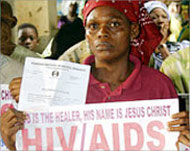UN issues grim AIDS warning
Deaths and new cases of HIV/AIDS reached unprecedented highs in 2003 and UN agencies warn the global pandemic is worsening by the day.

According to a new report from UNAIDS and the World Health Organisation (WHO) released on Tuesday, the epidemic has kept its stranglehold on sub-Saharan Africa and advances across Eastern Europe and Central Asia.
Around three million people will have died from AIDS this year, and five million more people will have become infected with the virus that causes it, the report said.
In their annual update on the HIV peril, UNAIDS and WHO estimate the global tally of people infected with AIDS or the human immunodeficiency virus (HIV) in 2003 to be around 40 million.
That compares with estimates a year earlier of 42 million people living with HIV/AIDS. But the agencies said the lower estimate was due to more accurate data and analyisis from 130 countries.
“Applying the improved tools and methods to previous years shows that there have been steady increases in the number of people living with HIV/AIDS, as well as in the number of AIDS deaths,” the 2003 AIDS Epidemic Update said.
Despite the lower figure, the agencies’ grim warning remained unchanged: the pandemic is pursuing its terrifying onward march in sub-Saharan Africa and is poised for an explosive breakout in parts of Asia and the former Soviet Union.
“The AIDS epidemic continues to expand – we haven’t reached the limit yet,” said Dr Peter Piot, head of the Joint United Nations Programme on HIV/AIDS (UNAIDS).
Sub-Saharan catastrophe
The number of people living with HIV/AIDS continues to increase in several regions, most markedly in sub-Saharan Africa, with southern Africa registering the highest prevalence.
“Asia and the Pacific as well as Eastern and Central Asia continue to experience expanding epidemics, with the number of people living with HIV/AIDS growing year by year.”
 |
|
Southern Africa sees a marked |
The statistical overhaul was caused in part by fresh data, such as national surveys of households and by UN census information that showed some countries in Africa have smaller populations than previously thought.
But experts also concluded the picture would be more reliable if they gave a range for their estimate rather than a single hard figure as before.
Thus the 40 million expressed for the global tally of people living with HIV/AIDS is halfway between a low of 34 million and a high of 46 million.
The range for new infections goes from 4.2 to 5.8 million, and the number of deaths in 2003 is from 2.5 to 3.5 million.
Pandemic varies
By applying the same tools to previous years, UNAIDS/WHO acknowledge that past estimates were at the high end of the scale.
In 2002, the 42 million figure would be downgraded to 38 million, in a range of roughly 32 to 44 million.
The planetary state of the pandemic remains very varied, as do the various motors for its spread, said the report.
It has been largely controlled in rich, western countries, where anti-retroviral drugs and good health systems have helped stem the tide.
|
“How long it will stay like this will depend on the vigour, scale and effectiveness of prevention, treatment and care programmes” UNAIDS and WHO |
In Latin America, North Africa, the Middle East and the Sahel, infection rates remain relatively low, at 0.7% of the adult population or less.
Sub-Saharan Africa, where the pandemic is mainly being spread by promiscuous heterosexual intercourse, bears the brunt of the crisis.
One in every 12 adult Africans has HIV.
The region accounts for two-thirds of total infections and AIDS deaths, reflecting the failures of awareness programmes and lack of access to the life-prolonging cocktail of drugs against HIV.
“How long it will stay like this will depend on the vigour, scale and effectiveness of prevention, treatment and care programmes,” UNAIDS and the WHO said.
“Urgent and dramatic headway is required on all these fronts, and in unison. Anything less will spell failure.”
Infection no longer limited
 |
|
AIDS activists want US govt to |
In parts of Eastern Europe, Central Asia, China, India and parts of Southeast Asia, infection that until now has been mainly limited to sex workers and intravenous drug users is now poised to leap into the mainstream population.
The report said the picture is not entirely bleak, however.
It noted that over the past two or three years, money has started to flow or been committed to Africa, from the Global Fund and US President George Bush’s AIDS initiative; that the cost of antiretrovirals is coming down; and countries are moving to set up coordinate programmes to distribute these precious drugs.
“But, measured against the scale of the global epidemic, the current pace and scope of the world’s response to HIV/AIDS fall far short of what is required.
“The struggle against AIDS has reached a crossroads: either we inch along, making piecemeal progress, or we now turn the full weight of our knowledge, resources and commitment against this epidemic. The choice is clear.”